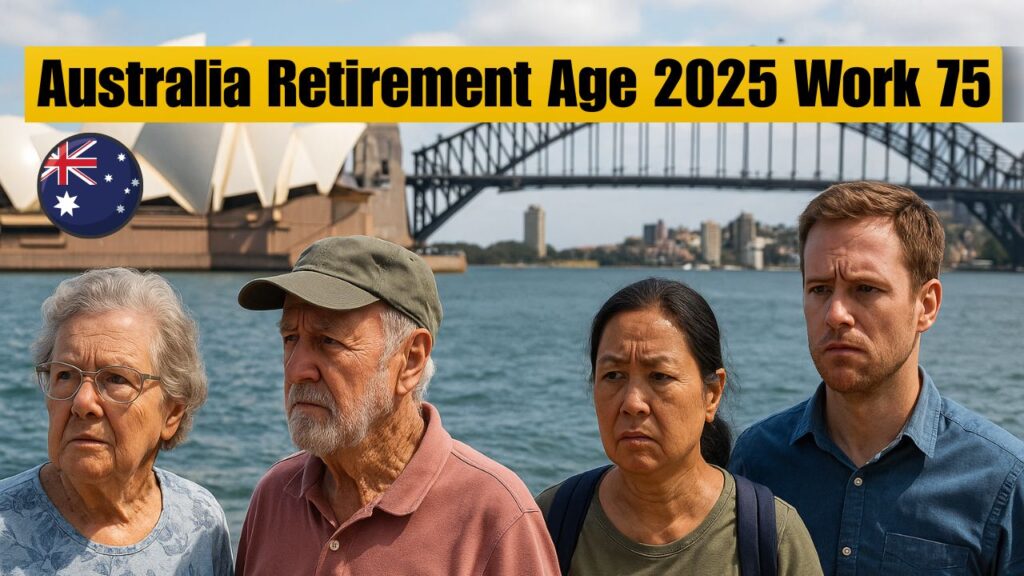Australians Government Retirement Age – The Australian government has once again announced changes to the official retirement age, sparking widespread discussions among Australian citizens about the future of work and pensions. Under the new proposal, the retirement age could gradually rise to 75, significantly altering long-term financial planning for workers across the country. Experts warn that this change could affect superannuation savings, retirement benefits, and overall lifestyle expectations for older Australians. While the government cites demographic shifts and longer life expectancy as reasons, many residents are concerned about the practicality of working longer and the impact on employment opportunities for younger generations.

Retirement Age Policy for Australian Workers
The latest policy adjustments by the Canberra government indicate that Australians may need to continue working well beyond 70, with gradual increments pushing the retirement age to 75. This reform aims to address increasing life expectancy trends and rising financial pressures on the pension system. For many middle-aged workers, this could mean reassessing their career plans, savings goals, and retirement readiness. While the government assures phased implementation and support measures, employees and unions are debating the feasibility of maintaining health and productivity into the late seventies, emphasizing the need for workplace flexibility and age-appropriate policies.
Superannuation and Retirement Changes in Australia
Australian financial experts highlight that the proposed increase in retirement age directly affects superannuation contributions and long-term savings strategies. Workers nearing 60 are encouraged to review their retirement plans to ensure sufficient funds for a sustainable lifestyle. The change may also influence investment decisions and encourage extended workforce participation, particularly in part-time or consultancy roles. Meanwhile, younger Australians entering the workforce will need to adapt to longer career spans, impacting job market dynamics and professional growth opportunities across industries. The government stresses the importance of proactive financial planning to mitigate potential challenges arising from the delayed retirement age.
| Age Group | Current Retirement Age | Proposed Retirement Age | Impact on Superannuation |
|---|---|---|---|
| 50–59 | 67 | 70 | Extended contributions required |
| 60–64 | 67 | 72 | Increased investment period |
| 65–69 | 67 | 75 | Higher pension eligibility age |
| 70+ | 67 | 75 | Workforce participation encouraged |
Extended Workforce Participation for Australians
With the retirement age potentially reaching 75, many Australian employees may consider flexible working arrangements, phased retirements, or consulting roles to maintain income and health. Employers are also preparing strategies to support older workers, such as ergonomic workstations, reduced physical demands, and professional development programs tailored to senior staff. Meanwhile, policymakers emphasize balancing the needs of older workers with the entry of younger talent into the labor market. This shift requires both cultural adaptation in workplaces and broader public understanding of financial security planning for longer working lives.
Impact on Pensions and Retirement Benefits in Australia
Increasing the retirement age significantly affects pension eligibility and government support schemes for Australians. Delayed access to benefits may require individuals to adjust spending habits and investment portfolios while relying on extended employment income. Social services also anticipate changes in demand for age-related programs and health support. Financial advisors recommend that citizens actively track their superannuation balances and consider diversified income strategies to ensure a comfortable post-retirement lifestyle, highlighting the intertwined relationship between government policy, workforce longevity, and personal financial security.
Frequently Asked Questions (FAQs)
1. What is the new proposed retirement age in Australia?
The proposed retirement age may gradually increase to 75 over the coming decades.
2. How does this affect superannuation contributions?
Workers will need to contribute for a longer period, increasing total superannuation savings.
3. Will older Australians still be eligible for pensions?
Pension eligibility will be delayed in line with the new retirement age increments.
4. Are there workplace support measures for senior employees?
Yes, flexible work options and health-focused accommodations are being encouraged for older workers.




